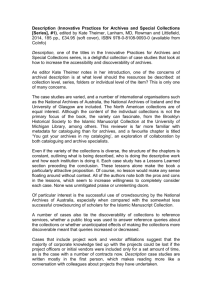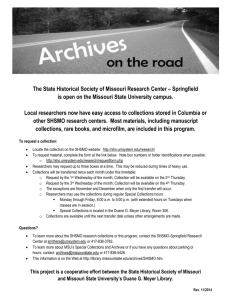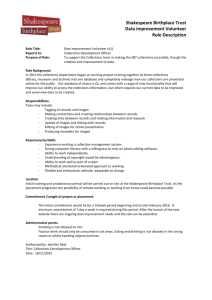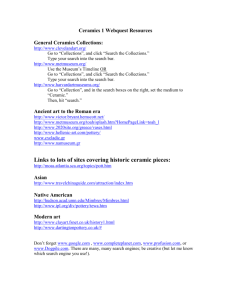Report
advertisement
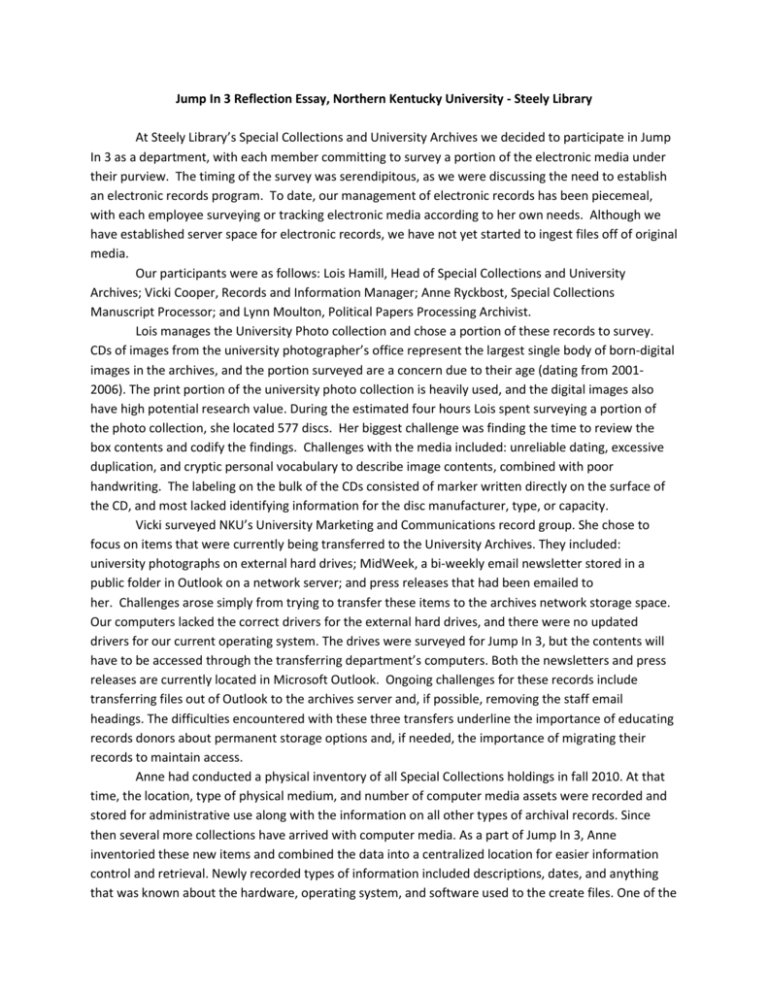
Jump In 3 Reflection Essay, Northern Kentucky University - Steely Library At Steely Library’s Special Collections and University Archives we decided to participate in Jump In 3 as a department, with each member committing to survey a portion of the electronic media under their purview. The timing of the survey was serendipitous, as we were discussing the need to establish an electronic records program. To date, our management of electronic records has been piecemeal, with each employee surveying or tracking electronic media according to her own needs. Although we have established server space for electronic records, we have not yet started to ingest files off of original media. Our participants were as follows: Lois Hamill, Head of Special Collections and University Archives; Vicki Cooper, Records and Information Manager; Anne Ryckbost, Special Collections Manuscript Processor; and Lynn Moulton, Political Papers Processing Archivist. Lois manages the University Photo collection and chose a portion of these records to survey. CDs of images from the university photographer’s office represent the largest single body of born-digital images in the archives, and the portion surveyed are a concern due to their age (dating from 20012006). The print portion of the university photo collection is heavily used, and the digital images also have high potential research value. During the estimated four hours Lois spent surveying a portion of the photo collection, she located 577 discs. Her biggest challenge was finding the time to review the box contents and codify the findings. Challenges with the media included: unreliable dating, excessive duplication, and cryptic personal vocabulary to describe image contents, combined with poor handwriting. The labeling on the bulk of the CDs consisted of marker written directly on the surface of the CD, and most lacked identifying information for the disc manufacturer, type, or capacity. Vicki surveyed NKU’s University Marketing and Communications record group. She chose to focus on items that were currently being transferred to the University Archives. They included: university photographs on external hard drives; MidWeek, a bi-weekly email newsletter stored in a public folder in Outlook on a network server; and press releases that had been emailed to her. Challenges arose simply from trying to transfer these items to the archives network storage space. Our computers lacked the correct drivers for the external hard drives, and there were no updated drivers for our current operating system. The drives were surveyed for Jump In 3, but the contents will have to be accessed through the transferring department’s computers. Both the newsletters and press releases are currently located in Microsoft Outlook. Ongoing challenges for these records include transferring files out of Outlook to the archives server and, if possible, removing the staff email headings. The difficulties encountered with these three transfers underline the importance of educating records donors about permanent storage options and, if needed, the importance of migrating their records to maintain access. Anne had conducted a physical inventory of all Special Collections holdings in fall 2010. At that time, the location, type of physical medium, and number of computer media assets were recorded and stored for administrative use along with the information on all other types of archival records. Since then several more collections have arrived with computer media. As a part of Jump In 3, Anne inventoried these new items and combined the data into a centralized location for easier information control and retrieval. Newly recorded types of information included descriptions, dates, and anything that was known about the hardware, operating system, and software used to the create files. One of the unforeseen issues that arose during this process was how to treat access copies (e.g. CDs of reel-to-reel recordings) that arrived with the collections as opposed to access copies that the department has created. In some cases, these copies are the only items the department is capable of playing back, greatly enhancing their value. The survey also revealed a gap between how legacy collections had had physical media stored versus how they are currently treated. Physical media has not been separated from other materials (e.g. paper) in most of the older collections. Lynn had captured the presence of electronic media in a full survey of U.S. Senator Jim Bunning’s Political Papers at the outset of that processing project in fall of 2014. At that time she only captured the location, media type, and number, and electronic media remained within paper records. By the time of Jump In 3, she had separated electronic media during the rehousing and arrangement of the paper records. This facilitated returning to the media to capture the remaining categories of information. The biggest challenge resulted from the limited amount of label information; while disc intellectual contents were frequently well defined, custom adhesive labels on many discs masked information concerning disc type, speed, and storage capacity. Almost no annotations were included indicating file types or the software needed to access media contents. One surprise result of the survey was from the tabulation of total volume of electronic media in the Bunning Papers. While the initial survey captured large items, such as hard drives, and items grouped together, such as a set of CDs containing interviews with Senator Bunning, most of the electronic media was missed in the initial survey. This is because the bulk of electronic records were present in the form of single discs included within folders of paper documents. Comparing results of the collection survey to the Jump in 3 survey gave us a good sense of how much media may be hidden in contemporary paper collections. This project helped us consolidate our individual findings in a single location, and to codify and unify what types of data we record about electronic media. We initially generated spreadsheet fields using OCLC Research’s sample inventory template; working with the template sparked conversations regarding useful metadata and ultimately increased the number of fields in our standard form. The resulting spreadsheet also now gives us a place to collect this information for media in new accessions going forward. Not only has participating in the survey reduced our backlog of undocumented digital media but by integrating this as a standard step for new collections, it will prevent a new backlog of unsurveyed media form developing. Our next steps include completing a survey for the parts of our holdings not covered during Jump In 3, and establishing standards for transferring files off of original media. Although the survey turned up concerns specific to certain records groups (i.e. redundant images and the likelihood of images with the same file name from the camera card being repeatedly used within university photos), jumping in has standardized our approach to electronic media and paved the way for our next step.


